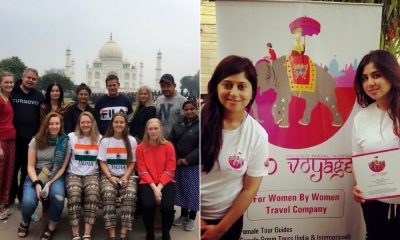Living
Ushering Springtime in Ladakh
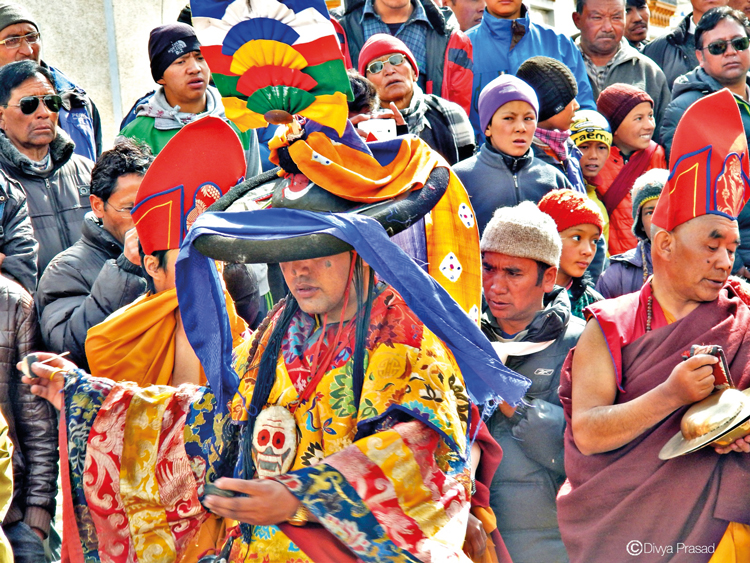
The Dosmoche Festival marks the end of winters, making way for the colours of Spring
Words by Divya Prasad
On a warm February morning, the cold winds coming from the far away mountains seemed to be asleep. Cymbals clank, trumpets sing, and drums play melodies of yore. Masked faces stand out amongst the blue skies and vast mountains. Prayers hummed in circles and a mist of incense smoke invade my senses on the narrow streets of Leh. Streets were filled with joy as the monks dance around and a sacred effigy makes its way through the lively by-lanes.
It is the time when the snowy peaks warm up, bursting in the colours of Spring. Little bazaars spring up in the lanes, selling happiness in packages to all. People from villages far away set out on a journey to honour and celebrate the Spring gods and goddesses. And Dosmoche marches forth, dancing in full glory.
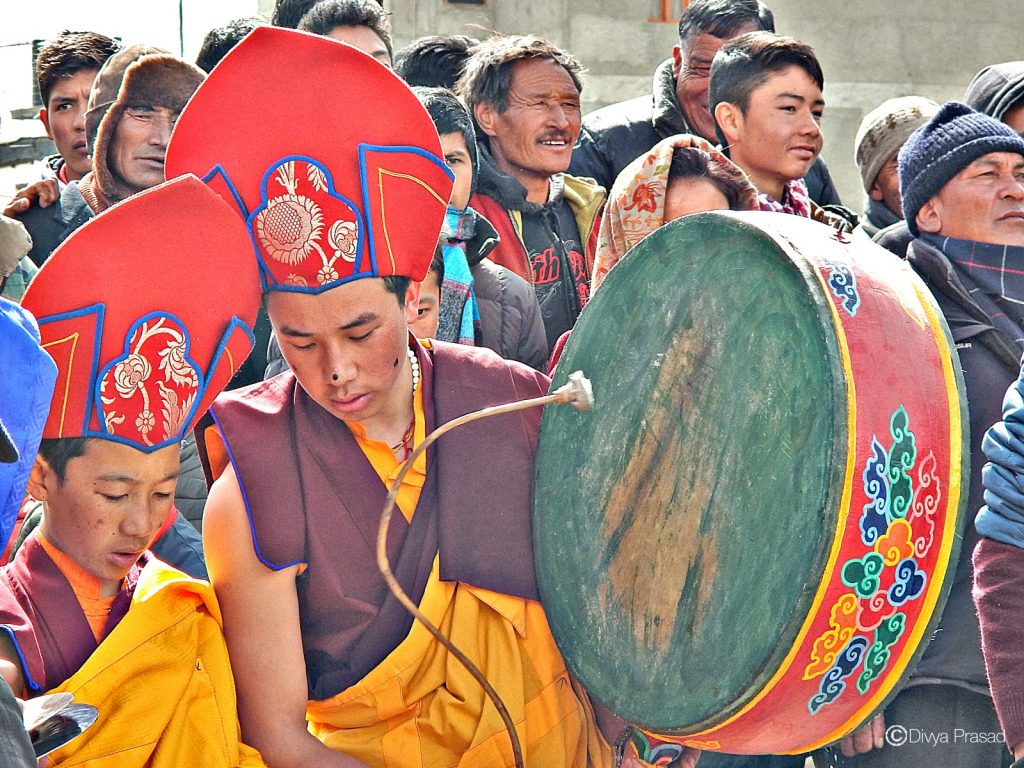
Welcoming Spring
The Dosmoche festival marks the end of winter and is a ritualistic celebration to welcome the spring. Symbolically, these Bön Buddhist animalistic tantric rituals are performed to ward off evil spirits and bring purity of thoughts as the Spring season sets in. It is a time to gather; and consciously cleanse and purify life. Metaphorically, it signifies releasing the evils of winter by appeasing the deities.
The Lamas wear masks, each representing an animal and deity spirit. They perform the Cham dance, swaying to the rhythm of drums, trumpets, and cymbals. Their inner power rises to the sacred beats and the holy smoke of Juniper leaves. In circles, they dance away into a state of trance. The ‘Cham’ represents the triumph of good over evil.
The legend of Cham dance
The sacred Cham dance was conceived by Guru Padmasambhava when Samye Monsatery was built in Northern Tibet. In ancient times, the Cham dance was a secretive tantric dance, the knowledge of which was passed on to a few chosen Lamas. Some Cham dances are also passed on by master lamas through mystical dreams and visions. A Cham is performed after five days of deep meditation, rituals, and chanting. The Cham also incorporates the nine ‘rasas’ of dancing. The Janak attires worn while performing the Cham represent deities, demons, and animals. The Cham dance is beyond the physical realm; it is metaphysical since it requires the monks to be in a transcendental state by forgetting the self. To understand the deities and be them as a means to enlightenment in the rituals is the essence of Cham. Being the deity and exorcising the evil forces; and show them the path to light is the sole purpose of Cham. While performing the ‘Cham’, the dancers identify with a particular deity, invoke them and conceiving the very universe as a Mandala with the deity. It involves rigorous chanting, gestures of hand and feet, yet being in a blissful state of meditation.
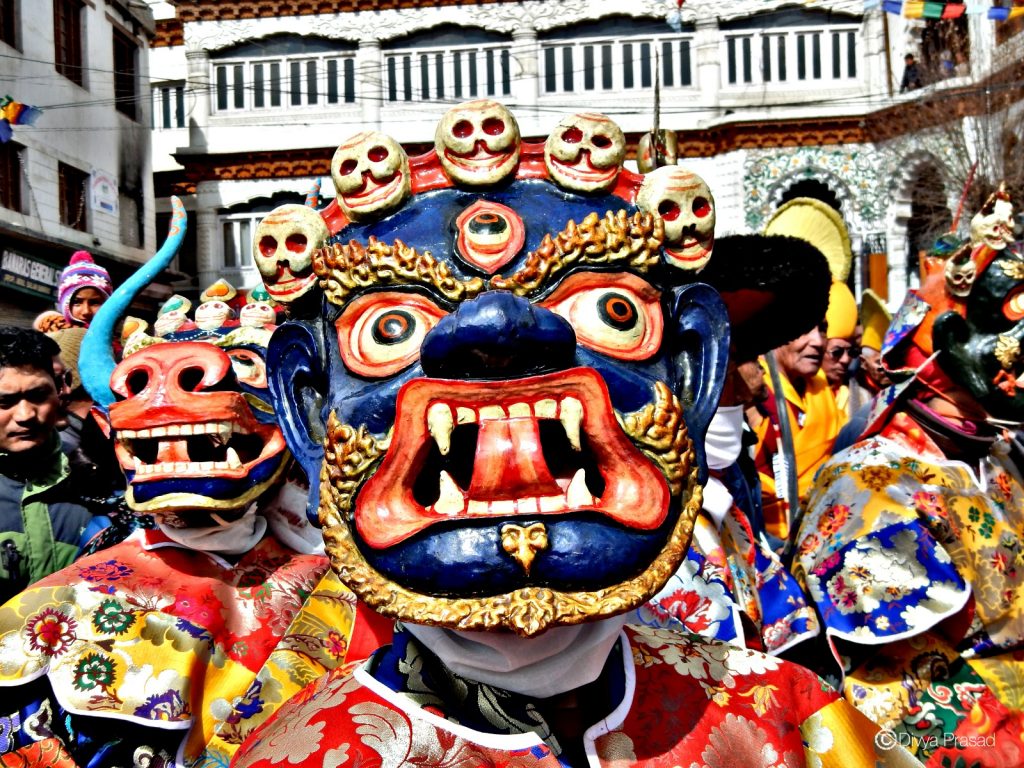
Legend has it that Guru Padmasambhava performed the first Cham in 770 AD to ward off evil spirits lurking around while building the Samye monastery. King Trishong Detsen called upon Guru Padmasambhava and invited him to Tibet to resolve this issue. The King and the artisans observed that every night, the evil spirits destroyed all that was created in the monastery that was under construction. This was disturbing the sanctum of the monastery. Guru Padmasambhava invoked his Tantric powers and performed rituals inside the monastery to spiritually cleanse the sacred space. In one of the rituals, Guru Padmasambhava buried five threads under the ground where the monastery stood, donning masks and a Janak attire; invoking the Chamara deity. He thumped and swayed in a trance, performing powerful Tantric mudras and postures to banish the evil spirits. Guru Padmasambhava drew Thiks – a sacred line in all directions to ward off the evil spirits. The Thiks kept the evil spirits from entering the monastery’s sacred space. It is also believed that Padmasambhava created the Vajrakila Mandala on Mount Hepori – one of the four sacred mountains of Tibet which is located in the east of Samye monastery. By creating this powerful tantric Mandala, Guru Padmasabhava pacified all disharmonious elements and evil spirits. This further appeased the local spirits and helped spread Buddhism. Thus, the Samye monastery was built like a Mandala – a sacred geometric pattern. The monastery complex is a Mandala representing the Buddhist universe while the main temple is built as a Mandala representing Mount Meru at the centre of this universe.
The Vajrakila dance performed by Guru Padmasambhava is also known for pacifying the angry ghost of Mashang Drompakye who harmed humans. Through this Vajra dance, Guru Padmasambhava transformed the soul into light and returned it to Sukhavati – the land of bliss. Since then, the Cham was passed on to King Trisong Detsen, his wife, and the generations ahead. The knowledge of ‘Cham’ is unwritten and can only be passed on spiritually. Today, the ‘Cham’ lives in the hearts and souls of a few older monks.
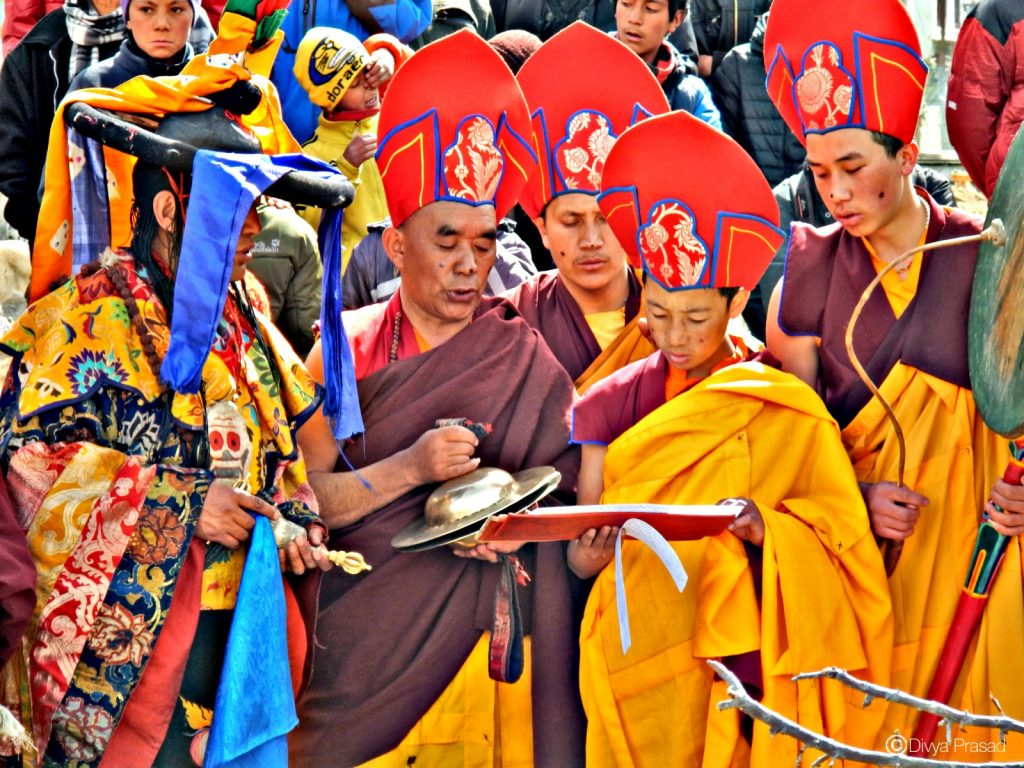
I immersed myself in the trance of the mystical dance, soaking in the stories narrated by a Lama who proposed to be my storyteller for the hour. The dancers chopped the air with their swords; stomping the dusty earth and invoking deities in their transcendental states through movements and gestures. The storyteller lama explained that the sword symbolises wisdom and the evil is the ignorance within us and that the path to enlightenment is the purpose of Cham.
The ceremonies were performed, as the masked lamas danced around the pyre. The Champson lead the sacred effigy created of wool, threads, butter, and barley to a gathering ground for a ritual to welcome the magic of Spring. This effigy; made of barley flour and butter represents the evil forces, which is cut with a sword by the Champson who invokes the evil into his own body. The effigy constructed over months by the Lamas with rituals and meditation is burnt to ashes, as the evil confronts death.
To me, the festival of Dosmoche was a lesson on life. A hope that spring is inevitable after a winter. That joy exists in each withering moments of life, if we can find the light in them. I feel grateful to have been a part of this sacred festival in the winters of Ladakh. While the wind carried its blessings through the ‘Lungtas’ fluttering high up in the snowy mountains, and prayers voiced through hearts; these mystical tales of light sprung forth in my heart.
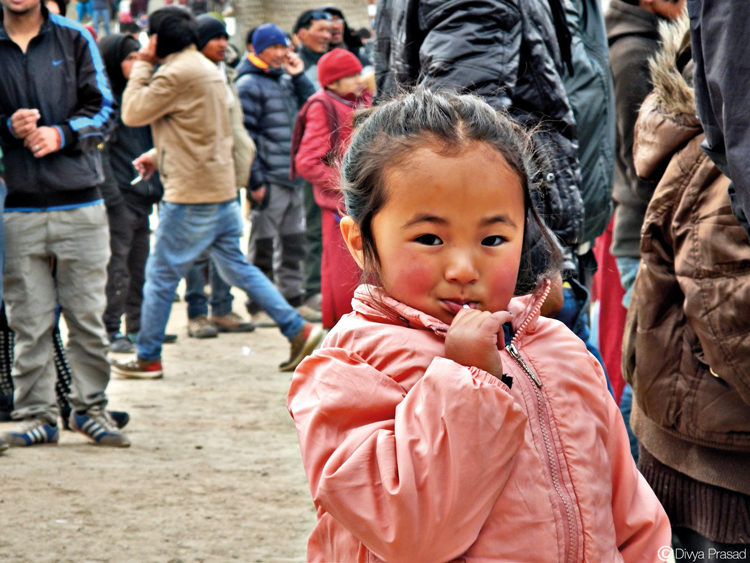
Author bio:
A travel blogger at Obsessive Compulsive Traveller, Divya Prasad is also an energy healer and Sacred Geometric Artist at Iktomi
Art
Navratri 2024: Celebrating the Nine Colours and Their Significance

Navratri, the festival that spans nine nights, is one of the most auspicious and widely celebrated festivals in India. Dedicated to the worship of Goddess Durga in her nine forms, each day of Navratri holds special significance, marked by a distinct color that carries deep spiritual and cultural meaning. As we prepare for Navratri 2024, let’s explore the nine colors associated with each day, their significance, and how they inspire devotion, positivity, and harmony.
Day 1: Yellow

On Thursday, embrace the uplifting energy of yellow as you celebrate Navratri with optimism and joy. This warm and cheerful color symbolizes happiness and radiates positivity, keeping you in high spirits throughout the day.
Day 2: Green

On Friday, wear green, a color that represents nature, growth, and harmony. It evokes a sense of peace and serenity, while also symbolizing new beginnings. Let the vibrant energy of green invite tranquility and the blessings of the Goddess into your life.
Day 3: Grey

Saturday calls for the subtle sophistication of grey. This balanced color keeps you grounded and calm, symbolizing composure and understated elegance. It’s perfect for those who want to participate in Navratri with grace while making a refined style statement.
Day 4: Orange

On Sunday, adorn yourself in the vibrant hue of orange. This color embodies warmth, exuberance, and positivity. Wearing orange during Navratri invokes an upbeat energy, bringing vitality and a lively spirit to your celebrations.
Day 5: White

Start your Monday with the purity and serenity of white. Associated with innocence and spiritual clarity, this color invites inner peace and helps you connect with the divine blessings of the Goddess, offering a sense of security and calm.
Day 6: Red

On Tuesday, red takes center stage, symbolizing passion, love, and strength. As one of the most auspicious colors, red is often offered to the Goddess in the form of a Chunri. Wearing red fills you with energy, vigor, and the vibrant spirit of Navratri.
Day 7: Royal Blue

Wednesday’s color is royal blue, representing elegance, richness, and tranquility. This deep, vivid shade of blue exudes confidence and sophistication, making it an ideal choice for those who want to celebrate Navratri with style and grace.
Day 8: Pink

On Thursday, don the charming hue of pink, a symbol of universal love, affection, and harmony. Pink is a color that adds a soft touch of warmth and approachability, making it perfect for creating a loving and joyful atmosphere during the festivities.
Day 9: Purple

On the final day of Navratri, purple takes the spotlight. Associated with luxury, nobility, and grandeur, purple invites opulence into your life. Wearing this regal color while worshipping Navdurga bestows blessings of prosperity and richness, making it the perfect way to end your Navratri celebrations.
Luxury
Cartier’s New High Jewellery Collection is a Love For The Wild

In 2021, the American Museum of Natural History in New York presented Beautiful Creatures, an exhibition showcasing some of the most eccentric jewellery designs of the past century. One standout piece was the iconic crocodile necklace of Mexican actress María Félix, a loyal Cartier patron. Félix, renowned for her bold sense of style, famously strolled into Cartier’s Paris store in 1975 with her pet crocodile, requesting a necklace in its likeness. Cartier delivered, crafting two intertwined crocodiles encrusted with over a thousand emeralds and yellow diamonds. For Félix, crocodiles symbolized freedom, an embodiment of the spirit she associated with Mexico’s Golden Age of cinema.

Fast forward to today, and Félix’s wildest dreams seem to have come to life at Cartier’s latest high jewellery collection, Nature Sauvage, previewed at the historic Kursalon Hübner gallery in Vienna. Among the star pieces is the Koaga necklace, a masterful creation where a zebra clasps an emerald-cut diamond and a 6.25-carat pear-shaped rubellite in its mouth. The zebra’s form is exquisitely rendered in alternating onyx stripes and pavé diamonds, making the creature feel almost lifelike.
The relationship between animals and jewellery has deep mythological roots, often glorified through rituals and symbolism. In ancient Egypt, scarab beetles were worn as earrings to signify respect for life’s cyclical nature. Meanwhile, in Hellenistic Greece, gods and goddesses took on the forms of winged creatures in adornment. So, what is it about animal-themed jewellery that continues to captivate us? According to Amanda Triossi, a jewellery historian based in Rome, the allure lies in our primal instincts: “Wearing wild animals like panthers or tigers gives one the sense of having conquered them. It’s empowering, as if you inherit the animal’s strength and attributes.”

Cartier captures this essence beautifully in its Amphista necklace. Featuring two intertwined snakes with diamond scales set with emeralds, their heads adorned with kite-shaped diamonds, the necklace echoes ancient Chinese philosophy’s yin-yang balance. The pièce de résistance? Nine octagonal Colombian emeralds, weighing a total of 14.72 carats.
Triossi also notes that many historical heroes are often depicted draped in the skins of animals they’ve vanquished, a symbol of triumph. Today, jewellery transforms that symbol into something precious and eternal—animal skins reimagined in imperishable materials.

Later that evening, at a celebration held at Vienna’s Kunsthistorisches Museum, the largest in Austria, the enchantment of Cartier’s collection was heightened. The museum’s octagonal domes featured paintings of animals dancing with angels, setting the stage for a magical night. Guests were greeted by masterpieces such as Rembrandt’s Self-Portrait and Caravaggio’s Madonna of the Rosary, alongside Cartier page boys in their signature red hats. The evening’s soundtrack, a seamless blend of Bach and Kygo, was curated by DJ Gillian Sagansky, lending a modern twist to the classical ambiance.
The following day brought another cultural adventure—a visit to Otto Wagner’s Villa, a stunning summer palace designed by the famed architect. The paintings adorning the villa’s walls depicted animals in various forms—some caught in purgatory, others wandering the biblical bardo, with alligators restlessly emerging from swampy landscapes.
Luxury
Indian Craftsmanship Meets Italian Savoir Faire : Rahul Mishra x Tod’s

Quiet luxury was expected to dominate for a while, with many predicting that the return of bold, extravagant fashion would take its time. However, maximalism seems to be making a swift comeback, especially in the realm of designer collaborations. Hot on the heels of the vibrant, print-heavy H&M x Anamika Khanna collection, another limited-edition line has arrived, celebrating opulent luxury: Rahul Mishra x Tod’s.
As part of Tod’s T-Factory project, which features exclusive collaborations with creative innovators, this marks Indian couturier Rahul Mishra’s debut in the international accessories space.

Mishra is a true ambassador of Indian design. Along with his wife Divya Mishra, he leads his eponymous label, which has brought the essence of India to the global stage in remarkable ways. A regular at Paris Fashion Week and the first Indian designer to showcase at Paris Haute Couture Week, his creations have adorned celebrities like Zendaya and Mark Zuckerberg, and have graced magazine covers in South Korea, China, and Europe. With such a path-defining legacy, it’s no surprise that Mishra and his visionary label were Tod’s natural choice for their first-ever Indian collaboration.
Mishra describes this collaboration as a beautiful fusion of “Italian craftsmanship serving as the canvas for Indian vision.” Tod’s iconic Gommino loafers and mules, along with the Di Bag and T Timeless shoulder bag, have been reimagined with intricate resham embroidery, crystals, and sequins—all meticulously hand-embroidered at Mishra’s atelier in Noida. “It was a technically challenging process that took time to perfect. I can confidently say these are some of the finest bags and shoes you’ll ever witness, in terms of craftsmanship and longevity. Such pieces are forever,” Mishra proudly shares.

Crafted entirely between India and Italy, the limited-edition pieces from this collection are a true love letter to the artisanal heritage of both nations. “There’s a beauty in the teamwork here,” Mishra explains. “We received raw materials from Italy and worked on integrating our embroideries seamlessly into their leather. The pieces were then sent back to Tod’s, where they transformed them into stunning, three-dimensional products. In that sense, it’s been a genuine collaboration between Italy and India.”
Mishra firmly believes that the future of global design will be shaped by a global Indian aesthetic. “Just as French, Italian, British, and Japanese designs are now seen as universal,” he explains. This collaboration marks a significant step in advancing that narrative. “When you push the boundaries of ‘handmade in India’ to be respected at the pinnacle of luxury, everything else will naturally follow,” he emphasizes.
-

 Style11 months ago
Style11 months agoBridal Guide : Best Looks of Radhika Merchant Ambani
-

 Fashion1 year ago
Fashion1 year agoMost Discussed Ajrakh Saree of Alia Bhatt
-

 Entertainment1 year ago
Entertainment1 year agoThe Most Stylish Guests of Bhagya Suresh Reception
-

 Entertainment1 year ago
Entertainment1 year agoBridal Bliss : All Bridal Looks of Swasika Vijay
-

 Movies1 year ago
Movies1 year agoA Nostalgic Journey Through Love &Cinema : Best Bollywood Romantic 90s Movies
-

 Fashion1 year ago
Fashion1 year agoMajor Denim Trends You Need To Know in 2024
-

 AD8 months ago
AD8 months agoPopular Curtain Fabrics to Consider for Your Home
-

 Events9 months ago
Events9 months agoBest of Fashion Looks : Diya Krishna Wedding










